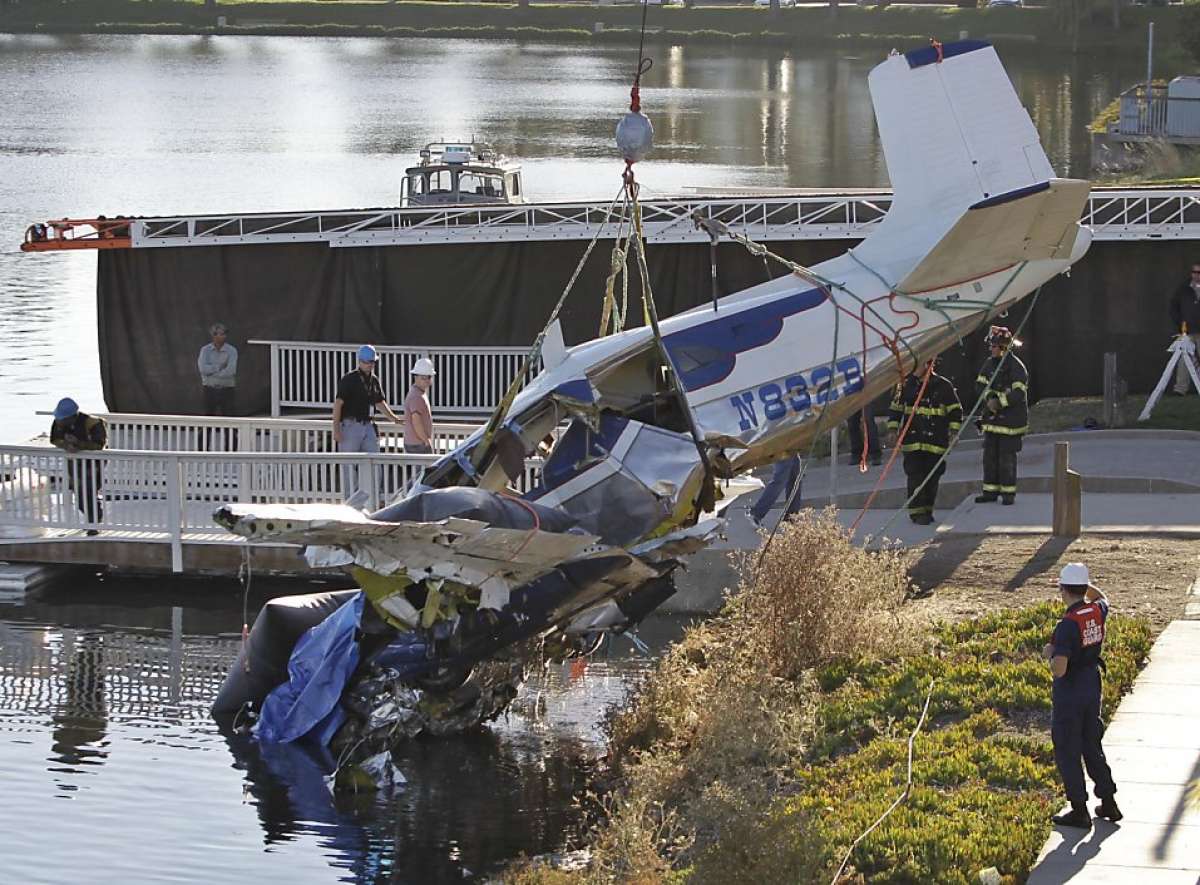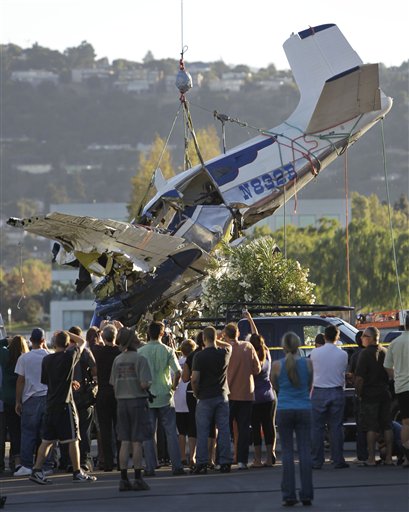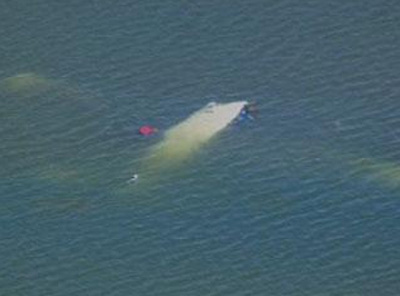Country
Crash of a Beechcraft A65 Queen Air near Tuguegarao
Date & Time:
Nov 29, 2010 at 1330 LT
Registration:
RP-C1111
Survivors:
Yes
Schedule:
Basco – Tuguegarao
MSN:
LC-270
YOM:
1968
Crew on board:
2
Crew fatalities:
Pax on board:
11
Pax fatalities:
Other fatalities:
Total fatalities:
0
Circumstances:
En route from Basco to Tuguegarao, the crew encountered technical problems and elected to divert to the nearest airport for an emergency landing. The twin engine aircraft stalled and crashed in a river. All 13 occupants, among them two children, evacuated safely. The aircraft damaged beyond repair.


Crash of a Beechcraft 65 Queen Air off San Carlos: 3 killed
Date & Time:
Sep 2, 2010 at 1151 LT
Registration:
N832B
Survivors:
No
Schedule:
San Carlos - Santa Clara
MSN:
LC-112
YOM:
1961
Crew on board:
1
Crew fatalities:
Pax on board:
2
Pax fatalities:
Other fatalities:
Total fatalities:
3
Captain / Total hours on type:
6000.00
Circumstances:
Shortly after takeoff for a repositioning flight for the airplane’s upcoming annual inspection, numerous witnesses, including the two air traffic controllers, reported observing the airplane climbing out normally until it was about 1/2 mile beyond the runway. The witnesses stated that the airplane then underwent a short series of attitude excursions, rolled right, and descended steeply into a lagoon. All radio communications between the airplane and the air traffic controllers were normal. Ground-based radar tracking data indicated that the airplane's climb to about 500 feet was normal and that it was airborne for about 40 seconds. Postaccident examination of the airframe, systems, and engines did not reveal any mechanical failures that would have precluded continued normal operation. Damage to both engines’ propeller blades suggested low or moderate power at the time of impact; however, the right propeller blades exhibited less damage than the left. The propeller damage, witness-observed airplane dynamics, and the airplane’s trajectory were consistent with a loss of power in the right engine and a subsequent loss of control due to airspeed decay below the minimum control speed (referred to as VMC). Although required by the Federal Aviation Administration (FAA)-approved Airplane Flight Manual, no evidence of a cockpit placard to designate the single engine operating speeds, including VMC, was found in the wreckage. The underlying reason for the loss of power in the right engine could not be determined. The airplane's certification basis (Civil Air Regulation [CAR] 3) did not require either a red radial line denoting VMC or a blue radial line denoting the single engine climb speed (VYSE) on the airspeed indicators; no such markings were observed on the airspeed indicators in the wreckage. Those markings were only mandated for airplanes certificated under Federal Aviation Regulation Part 23, which became effective about 3 years after the accident airplane was manufactured. Neither the Federal Aviation Administration (FAA) nor the airplane manufacturer mandated or recommended such VMC or VYSE markings on the airspeed indicators of the accident airplane make and model. In addition, a cursory search did not reveal any such retroactive guidance for any twin-engine airplane models certificated under CAR 3. Follow-up communication from the FAA Small Airplane Directorate stated that the FAA has "not discussed this as a possible retroactive action... Our take from the accident studies is that because of the accident record with light/reciprocating engine twins, the insurance industry has restricted them to a select group of pilot/owners…" Toxicology testing revealed evidence consistent with previous use of marijuana by the pilot; however, it was not possible to determine when that usage occurred or whether the pilot might have been impaired by its use during the accident flight.
Probable cause:
A loss of power in the right engine for undetermined reasons and the pilot’s subsequent failure to maintain adequate airspeed, which resulted in a loss of control. Contributing to the loss of control was the regulatory certification basis of the airplane that does not require airspeed indicator markings that are critical to maintaining airplane control with one engine inoperative.
Final Report:




Crash of a Beechcraft 65 Queen Air in Lawrenceville: 1 killed
Date & Time:
Feb 8, 2010 at 1705 LT
Registration:
N130SP
Survivors:
Yes
Schedule:
Lawrenceville - Lawrenceville
MSN:
LF-17
YOM:
1960
Crew on board:
1
Crew fatalities:
Pax on board:
3
Pax fatalities:
Other fatalities:
Total fatalities:
1
Captain / Total hours on type:
1332.00
Aircraft flight hours:
9234
Circumstances:
During the preflight inspection, some water was present in the fuel sample; it was drained until a clear sample was observed. Subsequently, the fuel tanks were topped off, and the remaining preflight inspection revealed no other anomalies. The pilot initiated a takeoff and upon reaching rotation speed, the airplane became airborne and the landing gear was retracted. The right engine immediately lost power, and the pilot feathered the engine and attempted to return to the airport. Shortly thereafter, the left engine lost power. The pilot informed the air traffic controller that the airplane had lost all power. The airplane subsequently collided with trees and terrain and a post crash fire ensued. A postaccident examination of the airframe and engine revealed no mechanical malfunctions or failures that would have precluded normal operation. Examination of fuel retrieved from the right main fuel tank, as well as fuel from the fixed base operator, revealed no anomalies. The left fuel selector valve was observed in the plugged port (no fluid flow) position, but it was most likely moved to that position during the accident sequence. The right fuel selector valve was partially aligned with the main fuel passageway and was unobstructed. The reason for the loss of engine power to both engines was not determined.
Probable cause:
The failure of both engines for undetermined reasons.
Final Report:










Crash of a Beechcraft 65 Queen Air in the Atlantic Ocean
Date & Time:
Jul 24, 1997 at 1620 LT
Registration:
N816Q
Survivors:
Yes
Schedule:
Kendall-Tamiami – Kingston
MSN:
LC-38
YOM:
1960
Crew on board:
2
Crew fatalities:
Pax on board:
3
Pax fatalities:
Other fatalities:
Total fatalities:
0
Captain / Total hours on type:
21.00
Aircraft flight hours:
4300
Circumstances:
About 1 hour after departure and 15 minutes after reaching the cruising altitude of 9,000 feet, the left engine quit. The flight crew feathered the left propeller and turned toward the closest
airport which was 80 miles away. The aircraft would not maintain altitude and entered a 500 foot per minute descent. About 20 minutes after engine failure the aircraft was ditched in the ocean about 50 miles from the closest airport. The flight crew and passengers were rescued the following morning and the aircraft was not recovered. The second pilot and owner of the aircraft stated the aircraft was about 90 pounds over the maximum allowable weight at the time of departure. The previous owner of the aircraft stated that both engines had exceeded the recommended overhaul time by about 450 flight hours.
airport which was 80 miles away. The aircraft would not maintain altitude and entered a 500 foot per minute descent. About 20 minutes after engine failure the aircraft was ditched in the ocean about 50 miles from the closest airport. The flight crew and passengers were rescued the following morning and the aircraft was not recovered. The second pilot and owner of the aircraft stated the aircraft was about 90 pounds over the maximum allowable weight at the time of departure. The previous owner of the aircraft stated that both engines had exceeded the recommended overhaul time by about 450 flight hours.
Probable cause:
Failure of the aircraft to maintain altitude for undetermined reasons following loss of power in one engine.
Final Report:
Crash of a Beechcraft 65 Queen Air in Campbellsville
Date & Time:
Jun 30, 1996 at 1240 LT
Registration:
N3870C
Survivors:
Yes
MSN:
LC-212
YOM:
1966
Crew on board:
1
Crew fatalities:
Pax on board:
3
Pax fatalities:
Other fatalities:
Total fatalities:
0
Captain / Total hours on type:
100.00
Aircraft flight hours:
2549
Circumstances:
According to an FAA inspector, the airplane '...was unable to get airborne...' during the takeoff roll. He stated that after travelling the full length of the 4,997-foot runway, the airplane ran off the departure end of runway 5 and continued approximately 2,257 feet through an open field, a fence, a corn field and into a depression where it impacted terrain and came to rest. The pilot reported that during the takeoff roll he discovered that he had not removed the gust lock from the control column and that his attempts to remove it were unsuccessful. The pilot stated that the aircraft '...went off the end of the runway through a fence and impacted an earthen berm that collapsed the gear [and] blade strikes that stopped the engines.'
Probable cause:
The pilot's inadequate preflight preparation, his failure to remove the control lock, and his failure to abort the takeoff.
Final Report:
Crash of a Beechcraft 65 Queen Air in West Point: 12 killed
Date & Time:
Sep 10, 1995 at 1840 LT
Registration:
N945PA
Survivors:
No
Schedule:
West Point - West Point
MSN:
LC-217
YOM:
1968
Crew on board:
1
Crew fatalities:
Pax on board:
10
Pax fatalities:
Other fatalities:
Total fatalities:
12
Captain / Total hours on type:
462.00
Aircraft flight hours:
1530
Circumstances:
The airplane was loaded with 10 sport parachutists and one pilot. Later, investigators calculated that the maximum gross weight was exceeded by 149.6 pounds, and the center of gravity was 2.87 inches aft of the aft limit. The cabin door had been removed for parachuting operations; however, an altered Flight Manual Supplement had been used as authority for the door removal. The airplane was not on the FAA-approved eligible list for such removal. The airplane needed to be refueled before flight, but the quantity of fuel in the airport's underground storage tank was below the electric cutoff level. Fuel was pumped manually from the storage tank into plastic jugs, which were used to refuel the airplane. Before takeoff, samples of fuel were reported to have been drained from the airplane's fuel tanks (sumps). According to witnesses, they heard an engine misfiring during takeoff. They observed the airplane level off during the initial climb and start a shallow right turn. The bank angle gradually increased from shallow to steep as the nose dropped and the airplane descended. Other witnesses observed the airplane in a steep dive just before it crashed in the rear of a residence. One person in the residence was killed. A postaccident fire destroyed the accessory sections of both engines. Examination of the airplane disclosed evidence that the right engine had been shut down and the right propeller had been feathered; however, no preimpact mechanical failure was found. A sample of excess fuel was obtained from the tank that was used to refuel the airplane, but no observable quantity of water or contamination was found.
Probable cause:
The pilot's inadequate preflight/preparation, his failure to ensure proper weight and balance of the airplane, and his failure to obtain/maintain minimum control speed, which resulted in a loss of aircraft control after loss of power in one engine. A factor relating to the accident was: loss of power in the right engine for undetermined reason(s).
Final Report:
Crash of a Beechcraft 65 Queen Air in the Caribbean Sea
Date & Time:
Aug 16, 1995 at 0720 LT
Registration:
N5078C
Survivors:
Yes
Schedule:
Christiansted – Roseau
MSN:
LC-12
YOM:
1960
Crew on board:
1
Crew fatalities:
Pax on board:
0
Pax fatalities:
Other fatalities:
Total fatalities:
0
Captain / Total hours on type:
950.00
Aircraft flight hours:
11650
Circumstances:
The pilot stated he noted a loss of oil pressure and a partial loss of power of the right engine during cruise flight. The engine then lost power, and the pilot was unable to feather the right propeller. The airplane would not maintain altitude and the pilot ditched the airplane about 75 miles southeast of St Croix. After exiting the airplane, the pilot inflated a raft, and was found by rescue personnel about 4 hrs later. The airplane was not recovered.
Probable cause:
Loss of engine power for undetermined reasons. Contributing to the accident was the inability of the pilot to feather the propeller.
Final Report:
Crash of a Beechcraft 65 Queen Air near Mauban: 5 killed
Date & Time:
Oct 27, 1993
Registration:
RP-C999
Survivors:
No
Schedule:
Manila - Virac
MSN:
LC-156
YOM:
1963
Crew on board:
1
Crew fatalities:
Pax on board:
4
Pax fatalities:
Other fatalities:
Total fatalities:
5
Circumstances:
En route from Manila to Virac, the twin engine aircraft lost altitude then crashed on the slope of a mountain located near Mauban. All five occupants were killed. It is believed that the pilot encountered engine problems for unknown reasons.
